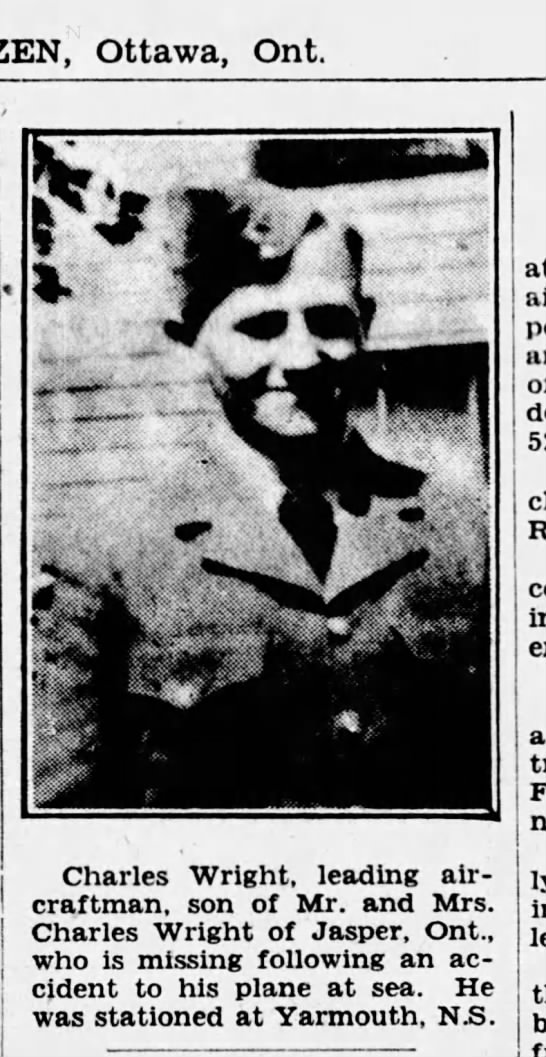
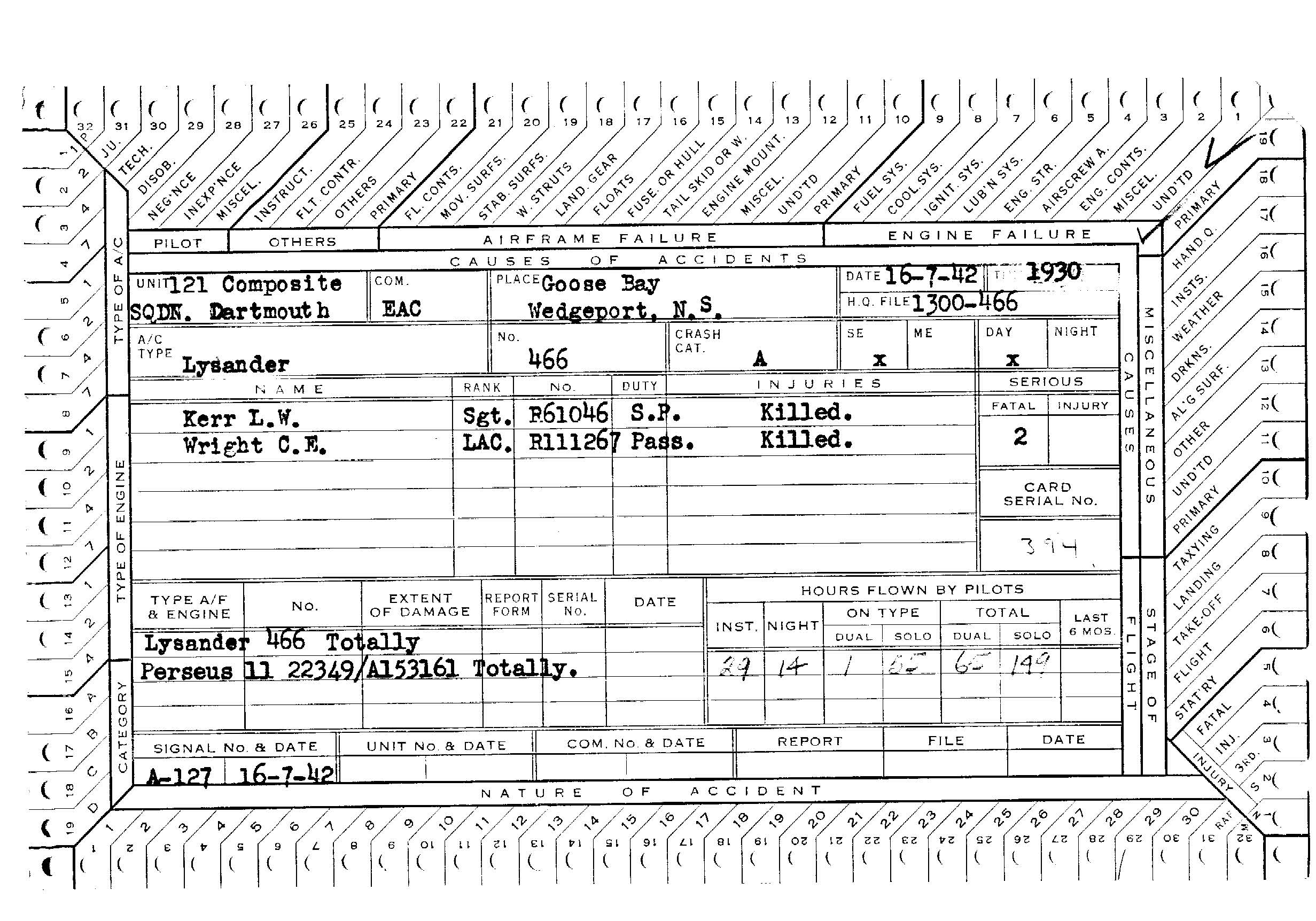
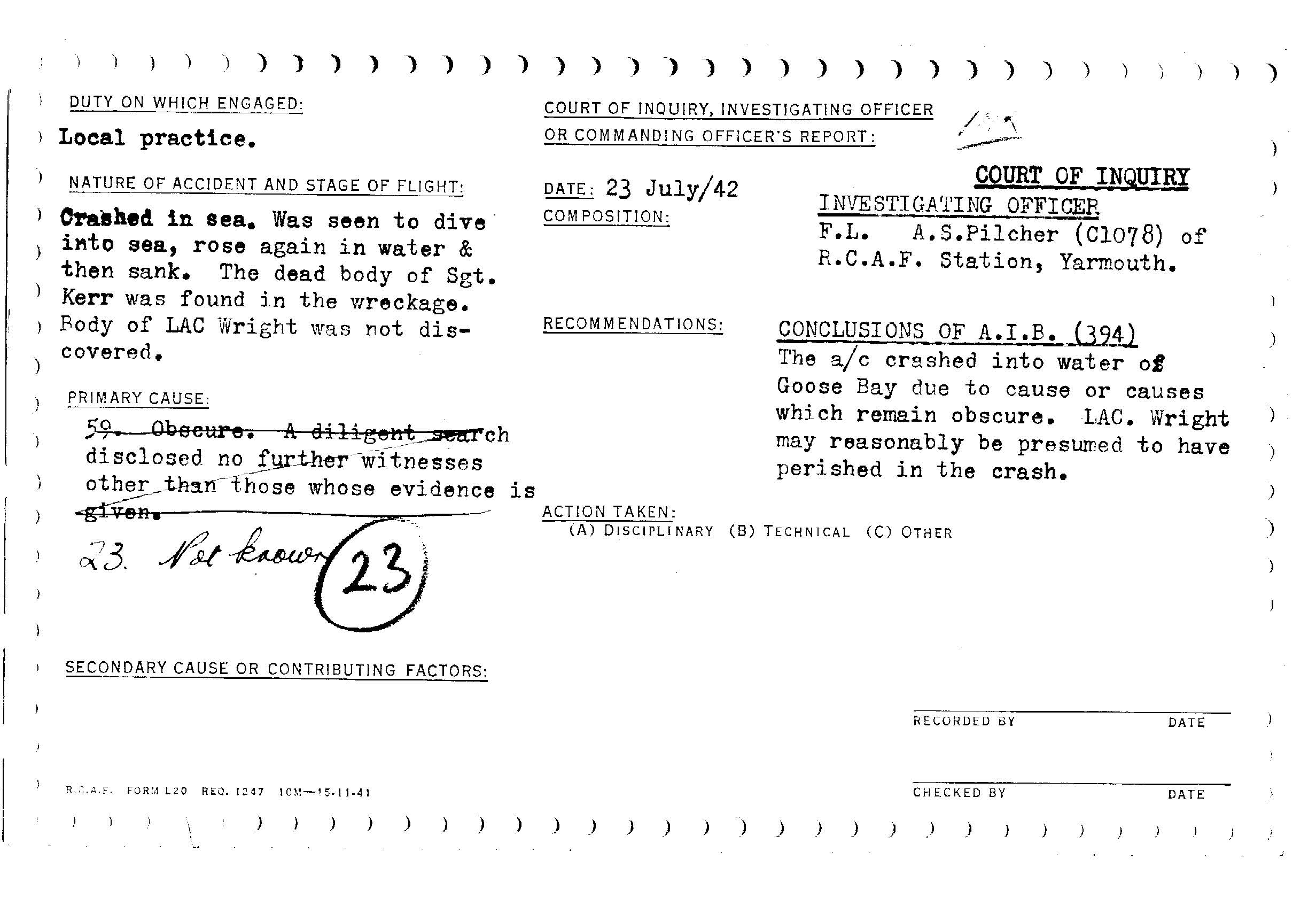
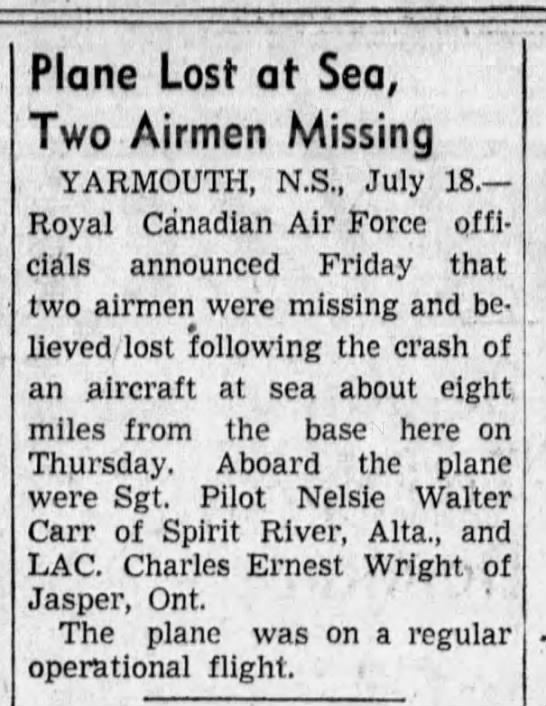
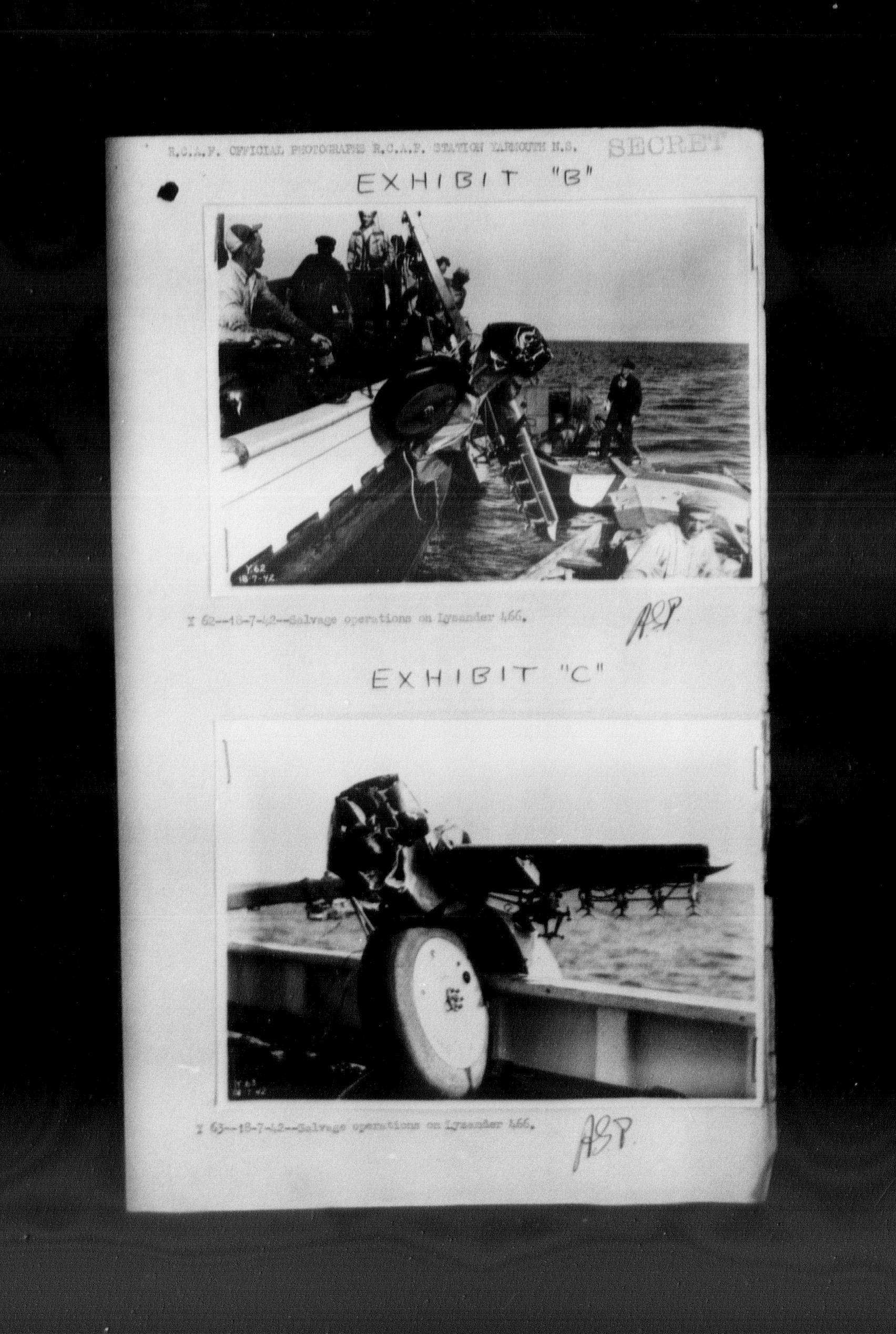
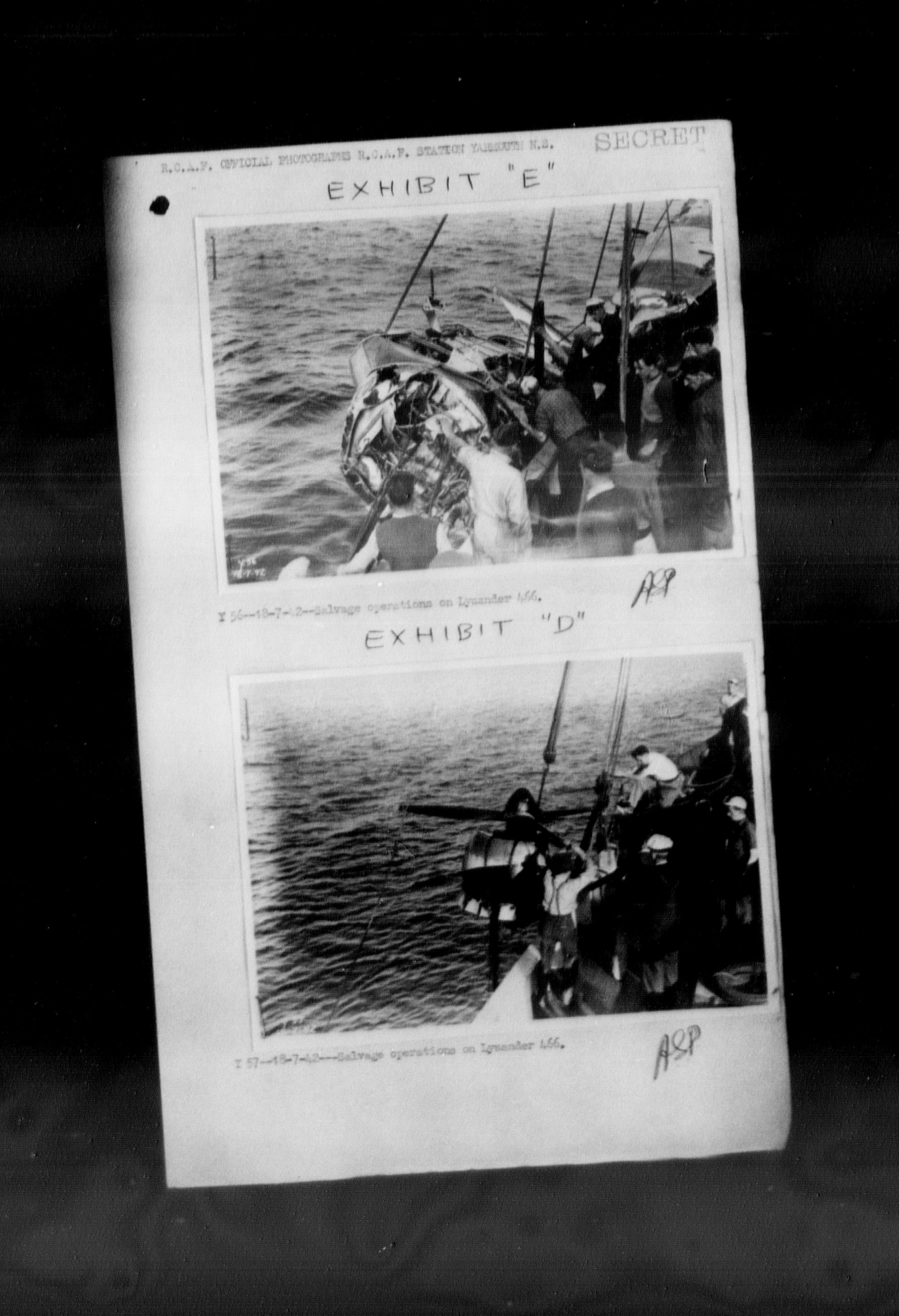
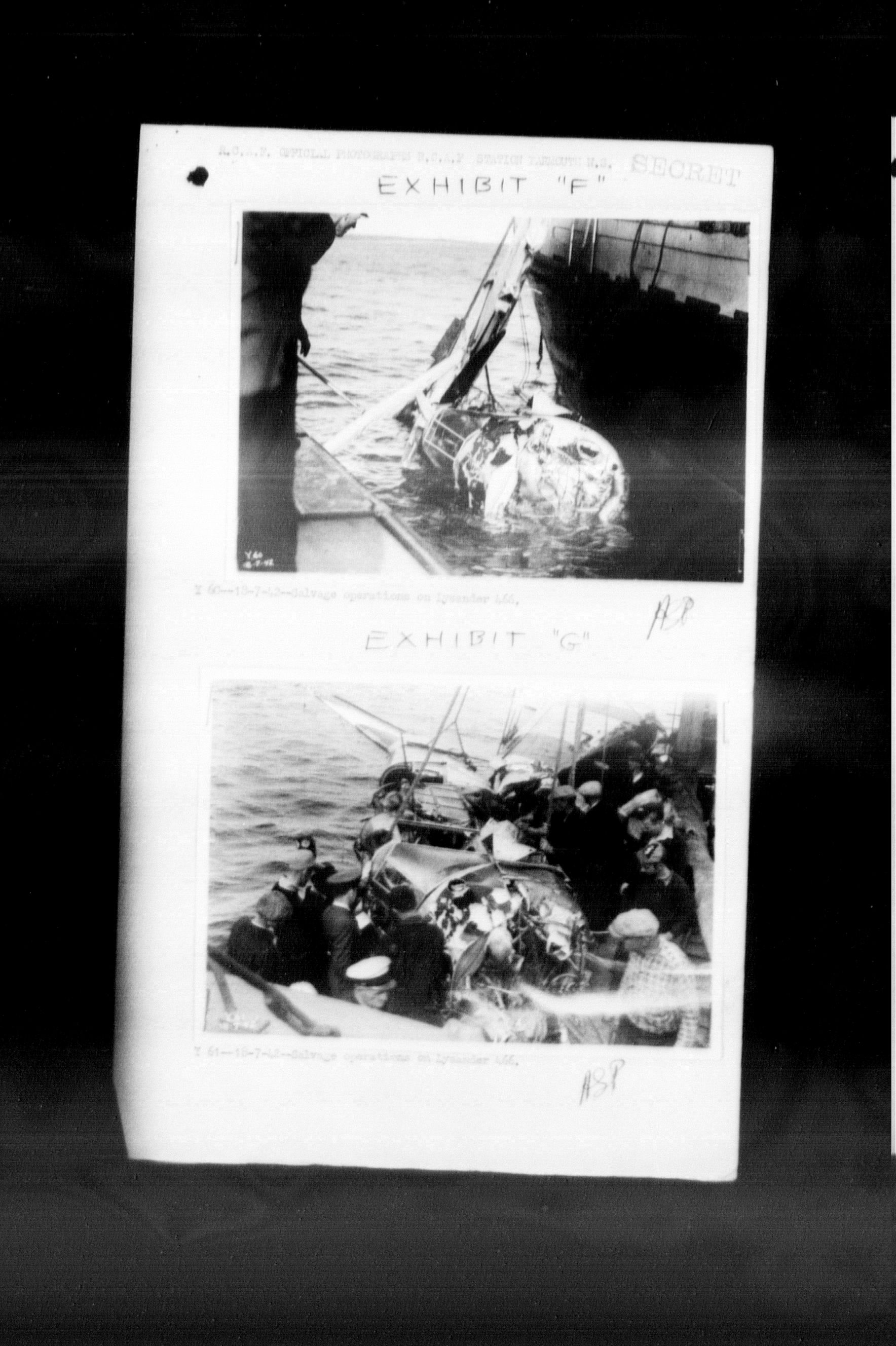
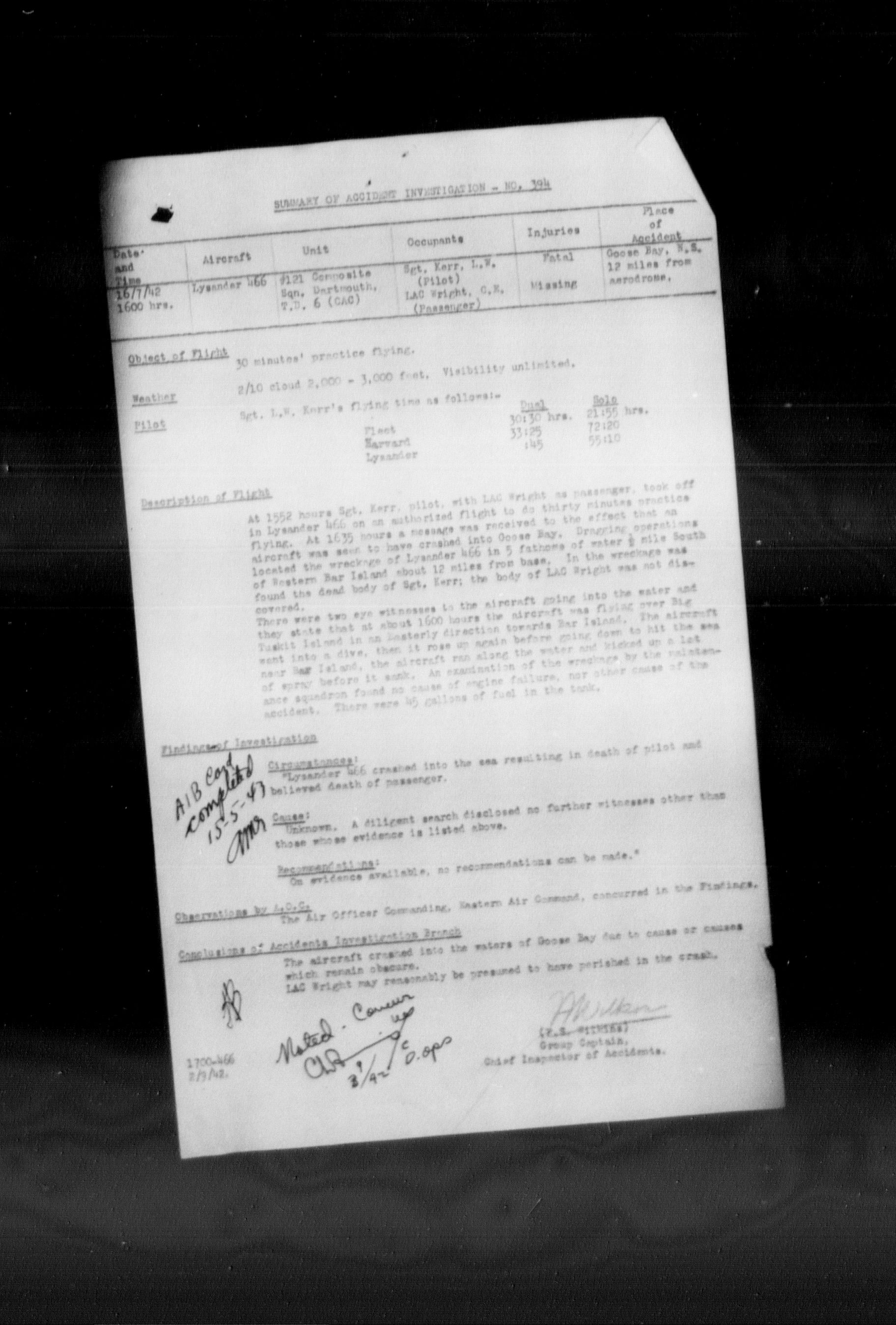
November 3, 1920 - June 16, 1942








Charles Ernest Wright was the son of Charles J. Wright (1881-1960), farmer, and Elizabeth (nee McKeown) Wright (1889-1971) of Jasper, Ontario. He had three brothers: WJ, Cecil, and James E. He had four sisters: Emma, Edna, D. Josephine, and Della E.
Charles has brown hair and hazel eyes, stood 5’8” tall and weighed 141 pounds. A scar under his chin, one on his right forearm and another on the outer side of his left leg were noted during his medical at No. 1 Manning Depot, Toronto, July 3, 1941. Two of his toes overlapped on both feet but caused him no disability. Charles had worked as a manager of a general store in Jasper, Ontario prior to enlistment in Ottawa, and planned on continuing as a retail merchant after the war. He enjoyed reading extensively, swam, played softball and hockey. He felt he was qualified to enlist as an equipment assistant.
His journey through the BCATP continued at No. 12 Equipment Depot, Montreal July 24 until August 29, 1941, then to E&A School, St. Thomas until October 10, 1941. He then was attached to No. 4 Repair Depot, Scoudouc, New Brunswick, then to RCAF Station, Dartmouth by March 1942. He was in Yarmouth, NS June 1942.
No. 121 Composite Squadron, Dartmouth, NS: Lysander 466 crashed into the sea at Goose Bay, Wedgeport, Nova Scotia. Aboard were LAC Charles E. Wright, passenger, and Sgt Pilot Leslie Walter Kerr, R61046, (1919-1942), of Edmonton, Alberta, pilot. “Lysander 466 crashed into the sea resulting in death of pilot and believed death of passenger. Cause: Unknown.”
From the crash card: “Local practice; crashed in sea. Was seen to dive into sea, rose again in water and then sank. The dead body of Sgt. Kerr was found in the wreckage. Body of LAC Wright was not discovered. Conclusions: The a/c crashed into water of Goose Bay due to cause or causes which remain obscure. LAC Wright may reasonably be presumed to have perished in the crash.”
NOTE: The newspaper article had misspelled the pilot’s name.
The Court of Inquiry can be found on microfiche 12340, starting at image 1725.
OBJECT OF FLIGHT: 30 minutes of practice flying. PILOT: Sgt. L. W. Kerr’s flying time as follows: Fleet Dual: 30:30 hrs, Solo: 21:55 hrs; Harvard: Dual: 33:25, Solo 72:20 hrs; Lysander: Dual: 0:45 hrs; Solo: 55:10 hrs. Total: 75 hours dual, 162 hours solo. DESCRIPTION OF FLIGHT: At 1552 hours Sergeant Kerr, pilot, with LAC Wright as passenger, took off in Lysander 466 on an authorized flight to do 30 minutes practice flying. At 1635 hours, a message was received to the effect that an aircraft was seen to have crashed into Goose Bay. Operations located the wreckage of Lysander 466 in five fathoms of water 1/2 mile south of Western Bar Island about 12 miles from base. In the wreckage was found the dead body of Sergeant Kerr; the body of LAC Wright was not discovered. There were two eyewitnesses to the aircraft going into the water and they state that at about 1600 hours the aircraft was flying over Big Tusket Island in an easterly direction towards Bar Island. The aircraft went into a dive, then it rose up again before going down to hit the sea near Bar Island. The aircraft ran along the water and kicked up a lot of spray before it sunk. An examination of the wreckage by the maintenance squadron found no cause of engine failure, nor other cause of the accident. There were 45 gallons of fuel in the tank.
The FIRST witness, F/L Donald Lorraine Forbes, C1007, General list, OC No. 6 CAC Detachment, Yarmouth, NS stated, “On July 16, 1942, at approximately 1500 ADT, I authorized a local flight to be made by Sgt. Kerr in Lysander 466. The duration of the flight was to be approximately 30 minutes. I authorized Sergeant Kerr to do half an hour practice flying. He could only communicate with the control tower by R/T.”
“Both airframe and engine inspected and found to be in order.” The SECOND witness, Cpl Lewis Harvey Fenton, fitter at No. 6 CAC Detachment confirmed this, as did the THIRD witness, AC1 Frederick Lorne Chalmers.
The FOURTH witness, LAC Walter Wilfrid Sullivan, R135260, clerk, stated, “On July 16th, 1942, at approximately 1540 ADT, LAC C. E. Wright who was a personal friend of mine, came into the Orderly Room to tell me that he was going to fly as a passenger with Sergeant Kerr. I went to the window of the Orderly Room and watched him climb into the aircraft. Shortly afterwards, I saw Lysander 466 taxi away from the hangar with him in the rear seat.”
The FIFTH witness, Sgt Gordon Francis Davidson, R56369, wireless operator stated, “On July 16th, 1942, Lysander 466 made good contact by R/T with the control tower before taking off from this aerodrome at 1552 ADT. After that time, I did not hear anything from the aircraft before it crashed.”
The SIXTH witness, S/L Howard Douglas Dewar, C1136, assistant controller in charge of Operations Room stated, “On July 16th, 1942, the records in Operations Room indicate that Lysander 466 took off base 1550 ADT ostensibly on local flying. At 1635 ADT Father LeBlanc of Comeau Hill phoned to the Operations Room and reported Miss Fanny Surette had seen a single engine aircraft with yellow and black stripes crash into Goose Bay. At 1639 ADT, Hudson 629 was ordered to proceed to Goose Bay to search for signs of the crash.”
The SEVENTH witness was Mrs. Surette. “I am Mrs. Surette, a resident of Comeau Hill. I live in a house at the south point of Comeau Hill. At about 4:00 PM on Thursday the 16th of July 1942, my daughter Fanny drew my attention to a single engine aeroplane which was flying over by Tusket Island in an easterly direction. The plane flew towards Bar Island and went into a dive. Then it rose up again before going down to hit the sea near Bar Island. I could see the plane run along the water and kick up a bit of spray before it sank. My house is 3 1/2 miles from Bar Island. I could not hear the engine of the plane before it crashed and my boy who was standing outside did not hear the engine.” A typed written note was added to the statement: “MRS. SURETTE AND HER DAUGHTER, FANNIE SURRETT, AGED 20, ARE VERY ILLITERATE PEOPLE, THE MOTHER BEING UNABLE TO READ OR WRITE AND THE DAUGHTER BEING UNABLE TO READ, AND WRITE HER SIGNATURE ONLY. THE MOTHER WAS UNWILLING TO SIGN THE STATEMENT WITH A MARK SINCE SHE COULD NOT READ IT, BUT STATED THAT AS READ TO HER, IT WAS CORRECT. THE DAUGHTER AGREED THAT THE STATEMENT AS READ PROPERLY, SET FORTH THE FACTS AND SIGNED ACCORDINGLY.”
The EIGHTH witness, WO1 Bruce Eisenhauer, R50037, Marine Section, RCAF Station, Yarmouth, NS stated, “I am employed as the Master of Marine Craft M447. On July 16, 1942, at 1640 ADT, I received orders from the Operations Room to proceed immediately to Goose Bay, where a Lysander was reported to have crashed. At 1730 hours ADT, I found a sea-marker which had been dropped by a Hudson. At 2045 hours ADT, I located the aircraft approximately ½ mile south of Western Bay Island at a depth of 5 fathoms. I marked the position and returned to Yarmouth at 2200 hours ADT. I picked up two small sections of the airframe. The weather: moderate westerly winds; good visibility with high ceiling.”
The NINTH witness, F/O Gordon Walton Appleby, J6282, pilot in No. 6 CAC Detachment, Yarmouth, NS stated, “On July 17th, 1942, at approximately 1100 hours 8 DT, I proceeded in M447 to the scene of the crash of Lysander 446. At 1200 hours ADT, the crew of M447 commenced dragging operations. A salvage boat, ‘Flojald II’ from Yarmouth join us at approximately 1630 ADT. The crew of M447 had salvaged the starboard wing before the salvage boat arrived. By 2200 hours ADT, the undercarriage, engine, and propeller had been raised to the surface. Salvage operations were then discontinued until 0600 ADT the following morning. The port wing and fuselage containing Sergeant Kerr’s body was salvaged at 0815 ADT. The M447 returned to Yarmouth at approximately 1030 ADT with the body of Sergeant Kerr. The Flojald II returned with the remains of the aircraft. There was nothing in the appearance of the wreckage which could show why the aircraft landed in the water. We could find no trace of the body of LAC Wright.”
The TENTH witness, F/S Walter John Bateson, Maintenance Squadron, Yarmouth stated, “On Saturday July the 18th, 1942, the salvaged remains of Lysander 466 were delivered to our maintenance hangar. Acting on F/L Bradford’s orders, I dismantled the engine and carried out anti-corrosion measures to prevent further damage to the parts. Having stripped the engine completely, I could find no evidence of any mechanical defect which could have led to engine failure. When the fuel tank was emptied, there were approximately 45 gallons of gas drained from it. I could find nothing in the salvage remains of the aircraft which suggested to me a possible cause of the crash.”
The ELEVENTH witness, John Dobson, civilian employed by the Department of Transport, officer in charge of the Met Section at Yarmouth stated, “On July 16th, 1942, from 1200 hours ADT to 1700 hours ADT, the visibility at Yarmouth was unlimited and there was 2/10 cloud at 2000 to 3000 feet. The wind was west from 8 to 12 mph.”
The TWELFTH witness, Cpl. Lewis Caldwell Horne, photographic section, stated, “On July 17th 1942, I went aboard the RCAF crash boat B123, and proceeded to Goose Bay, where salvaging operations were being carried out on Lysander 466. During the late afternoon and evening, some parts of Lysander 466 for salvage. I took some photographs which I here produce in evidence. On the morning of the 18th, I took photographs of the fuselage containing the body of Sergeant Kerr, which I here produce in evidence.”
The wreckage of Lysander 466 was recovered as was Kerr’s body. “1 ½” wound forehead mid-way between left supra orbital margin and hair line; superficial 1” wound, 2” above right knee; death by drowning.” He was buried at the Mountain View Cemetery, Vancouver, BC.
Kerr was assessed: “This student was very slow to absorb instruction (flying), although very willing to learn. Should make a good single engine pilot. Ground: only average ability and not a great deal of application. Has done quite well considering his comparative lack of educational background.” No. 22 EFTS, December 22, 1941.
A letter written by Mrs. Wright dated June 14, 1943 to the Estates Branch: “I read your letter dated May 31 and thank you. You mention about the home Charles left me. It is in his name and mine and is the only home I have so I will never sell or dispose of it in any way, so is it not allright [sic] just the way it is? I have not been to any solicitor or anyone since Charles went home. It will only mean expense to me and you say you can split Charles’s bank balance and put in my name. I will thank you for doing that, but if it is not really compulsory for me to see a solicitor reg. my home Charles bought for me. I will not. I rec’d Charles’s clothes, I thank you for them. I hope I have answered your questions satisfactory, if not, let me know what you wish me to do.” Charles had $11.42 in his bank account at Smiths Falls. “The home in which he lived was bought and paid for by himself and he had the deed put in his name and mine, that is, it was mine while I lived, then of course, it would be his,” wrote Mrs. Wright on the Estates form.
On August 1, 1945, Mrs. Wright wrote a letter to the Department of National Defence, Ottawa. “No one can tell how glad I was to get your letter with hopes of you sending me what my son would be still sending me had he been left, as your files will show you, I wrote you for support when my son was stopped from sending it. Now I do hope you will find it in your heart to give me something. Your agent said when here, he could not give it because my husband lived under the same roof. Now will you please take means to separate him from my home. You have the money to do it which I haven't. I do not receive one cent from him. You had plenty of proof when you investigated before and he is still the same and what can I do. Your investigator knows when he was here that Charles was my only support in money. The other children keep me in wood and a few other little things off their farm. There isn't any need of me repeating anything as the gentleman who was here can tell you all, you don't have to take my word. Ask the gentleman who my boy worked for up to his enlistment or our doctor or in fact any man in our village. I am now getting $8 a month for my youngest girl 15 years, which is meaning a great deal to me. My son’s last words are coming true I never doubted them. He always said don't worry mother, you will never want. I will see to that. And now your letter. Please investigate and see again if I am worthy of something. Thanking you.”
In October 1945, Mrs. Wright was noted as the sole beneficiary of Charles’ estate, and she received $90.00. She had received $20.50 in September 1943 and $19 in October 1943.
LINKS: